We-Write #15: November Partner Week (Art Class)
@zeldacroft, @freewritehouse
Partnership: @phil-glaz , @mgaft1
The contest
Today, I for the first time brought my children to the art class here in Chicago. It is good that they will study in the States from the very beginning. In today’s Russia, they wouldn’t have opportunities. Let them take their first steps here in a big way...
I remembered how I was first brought into a similar "art class" in a small Russian city, far from the capital. Long northern nights, factories, monotonous five-story buildings surrounded by many coniferous trees. It probably looked like Detroit in the early 20th century.
Yeah, it was the beginning of the 1990s, the time when Russian people very quickly became very poor. There was no work, no money - but there it was - the first Western goods appeared in kiosks: Snicker bars, Pringles chips, Wrigley's gum... Interesting time – we were as if meeting an alien civilization.
That winter of 1991, my mother brought me to the art school for kids. The school offered different classes: drawing, singing, dancing, and acting. I didn't like painting and dancing at all. I couldn't sing, but I liked the process of it - we were taught to play simple melodies on xylophones. Besides, I didn't like singing "the stupid children's songs," even though I was only five years old. I don't know what I wanted...Perhaps, I wanted to recite the words of rap.
Yet, playing in a children's play was cool! We all played different animals. I have the role of a dog, and I had to bark very loud. I recall that at all rehearsals I didn’t bark in full voice. Although at the final performance, in front of parents, I surprised everyone, barking as hard as possible.
I remember the building where our classes took place then, as a child. To the people of modern Chicago, it would seem a strange monument of architecture. It was a Soviet so-called "the house of culture," built in the style of German architecture by Germans prisoners of War in the 1950s, after the war. Entire neighborhoods were composed of those buildings.
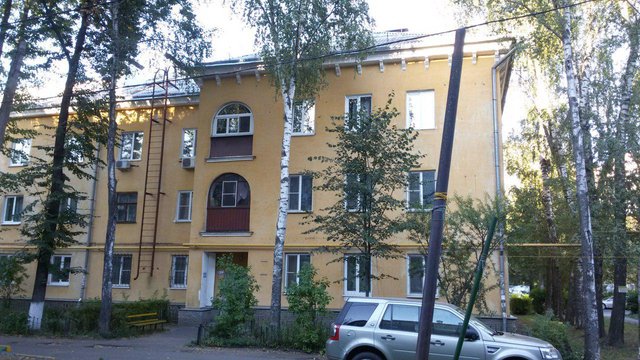
(Author's photo)
In general, on the outskirts of many Russian cities, there are such neighborhoods, which could be called "little Germany." When I became an adult and for some time lived in Saratov, a city located a thousand kilometers from my hometown – on one of the outskirts of the city I also discovered there the same "little Germany." In many Russian cities where I have never been, "small Germany" also exists. Three-story houses, parks, and "houses of culture" – all looking exactly the same and very "not Russian." They contrasted with old wooden barrack type houses and Soviet five-story boxes.
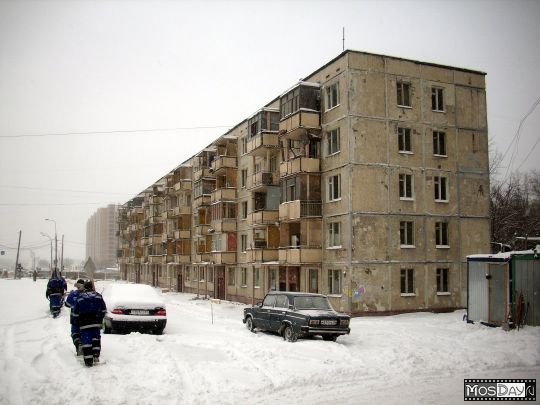
Yeah, “Little Germanys” built by German prisoners of war. There were thousands of them captured after Stalingrad and especially after the operation “Bagration” in Belarus. In 1944 many of them were brought to Moscow and made to march through Red Square.
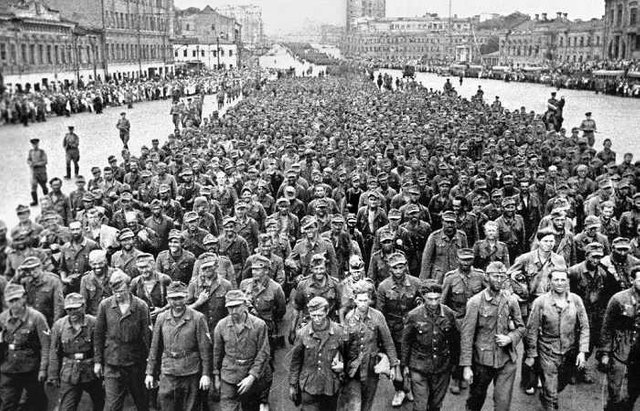
Source
Stalin did it to assure Roosevelt and Churchill in the victory of that operation. Yeah, German prisoners of war – they were treated lousy in GULAL, just as lousy as the incarcerated Russians who were there. Lots of them died from hunger, frost, and slave labor building houses for “Little Germanys” and much other stuff. Only after the death of Stalin in 1953, those who survived were sent back to Germany.
Strange thing. Germany – the country of Durer, Shiller, Goethe, Kant, Gauss, Mozart, Beethoven, Leibnitz and then all of a sudden Gering, Gables, Himmler, Hitler. How did it happen? That horrible scary war. Millions of tortured and dead. I can’t even imagine how one could sit in the trench with Molotov cocktail and see how a tank moves toward you, and you have a choice of straightening up and throw the bottle in the tank and be shot from a machine gun, or be squashed by the tank’s caterpillars. Death - mutual destruction.
That’s what Picasso depicted in his famous picture “Guernica.”
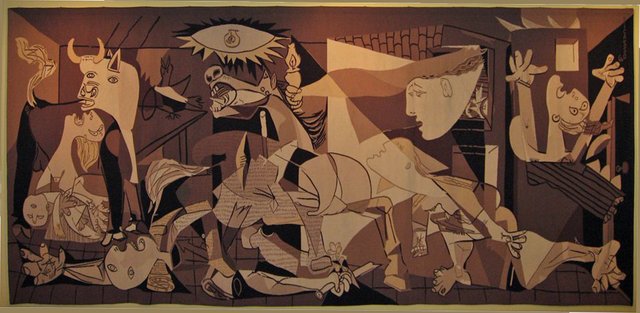
They say nations deserve their leaders. If that so, then I guess Germans deserved Hitler just as much as Russian deserved Stalin. I read somewhere that before signing the Molotov-Ribbentrop pact, Hitler sent his photographer to Moscow to make for him photos of Stalin. Then for a long time, he sat and studied them with the magnifying glass making sure that Stalin wasn’t a Jew.
Yeah, and then there was Nuremberg’s process where all these Nazi’s big cheeses were charged and most of them executed.
Nuremberg - the hometown of Albrecht Durer. One of my favorite artists.
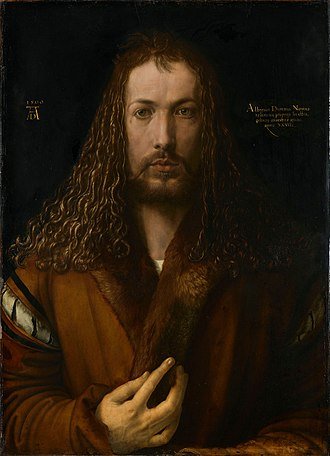
Here he was born a long time ago, in 1471. His father wanted him to continue the family trade – jewelry business, but the young Albrecht insisted that he wanted to be an artist and at the age of fifteen, he started to take art classes from a German painter and printmaker, Michael Wolgemut. And he became who he became one of the greatest artists of the Renaissance. Albrecht was one of three surviving kinds in his family. Three of eighteen. Medicine and hygiene sucked during the Renaissance. If today’s German women would be as productive as Albrecht’s mom Barbara Durer, Angela Merkel wouldn’t have to deal with the immigration problem.
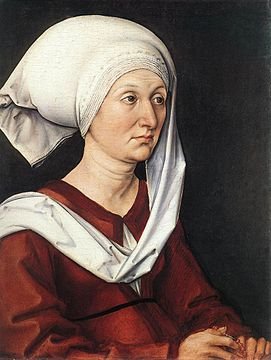
I wonder, as a great artist, Durer could foretell the future, and in some strange way could reflect on it in this painting
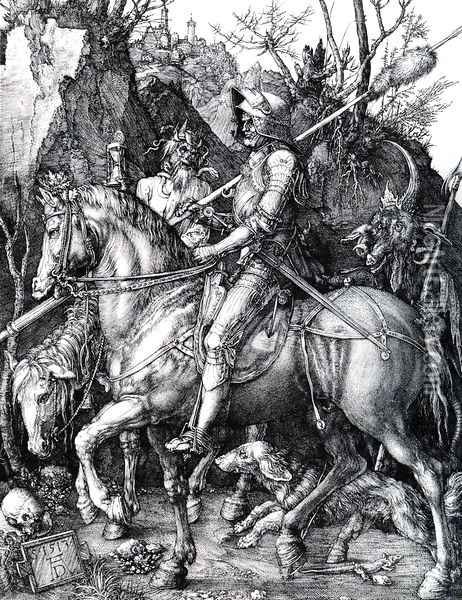
Source
Anyhow, I think it 's good that my children would never live in "little Germany." There is a certain beauty in those neighborhoods, but it’s much better remembering this beauty when you don’t live there, but live somewhere where it is warm, sunny and democratic.
When I was a pupil, all I dreamt about how I would leave this poor industrial city - and go to a large city like Moscow, which is so different from our quiet streets with conifer trees. Now, after many years, it's even nice to remember my childhood. But to stay for the entire life in those small towns, raise children there and take them to the same art class in the "house of culture" in the middle of "little Germany?" Thanks, but no thanks! I think they are much better suited to Chicago.
Let hope that this art class will teach them something beautiful; more about Dürer than about Der Führer.
This was a really interesting read, @phil-glaz and @mgaft1! I like the ties between art and history. Nice job!
Thank you! We are glad you liked it. )
Всё-таки сложновато получилось в итоге... с размышлениями о фюрере и судьбах немецкого народа. В другой раз попроще что-нибудь придумаем. Да и у меня вроде побольше свободного времени становится)
Да уж. Спугнули мы их. Но вроде ничего неуважительного я о немцах не говорил.
Прочитал о Дюрере, что он родился в Нюрнберге, и вспомнилось из фильма "Хроника пикирующего бомбардировщика."
-- Эх Ваня (или Петя, Вася) у них щас не Дюрер, у них щас Фюрер
Жалко было такое упускать. Уж больно хотелось ознакомить публику с классикой советского кинематографа. Ну вот я к этому все и подогнал.
Но видно не в то горло пошло. )))
А я и не помню этой шутки из советского фильма) Поэтому - тоже не понял юмора))
Дюрер как один из величайших представитель немецкого гуманизма и фюрер - это как обращались к Гитлеру. )))
A good story that transcends fiction to recreate times and spaces related in some way to life and art. Well done, @mgaft1!
Thank you! Good to hear from you.